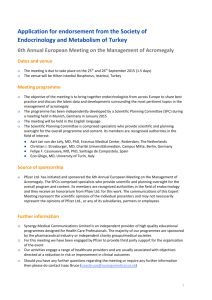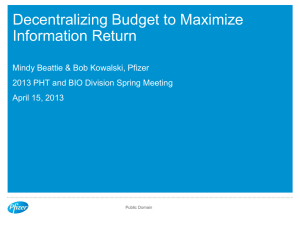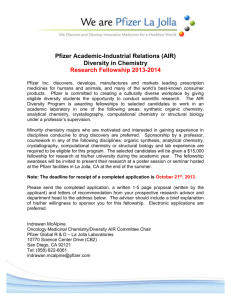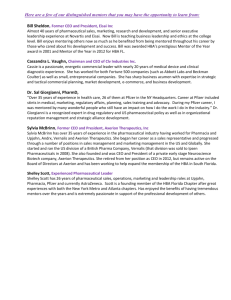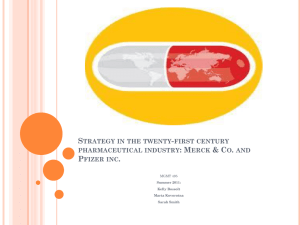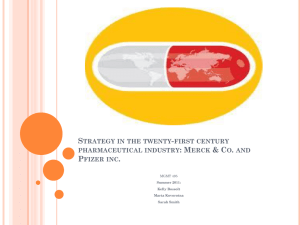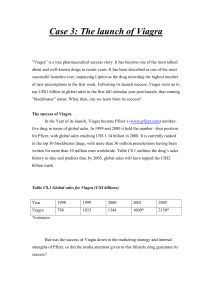Pfizer Finds Its Ad Groove: An amusingly sunny Viagra spot, smart
advertisement
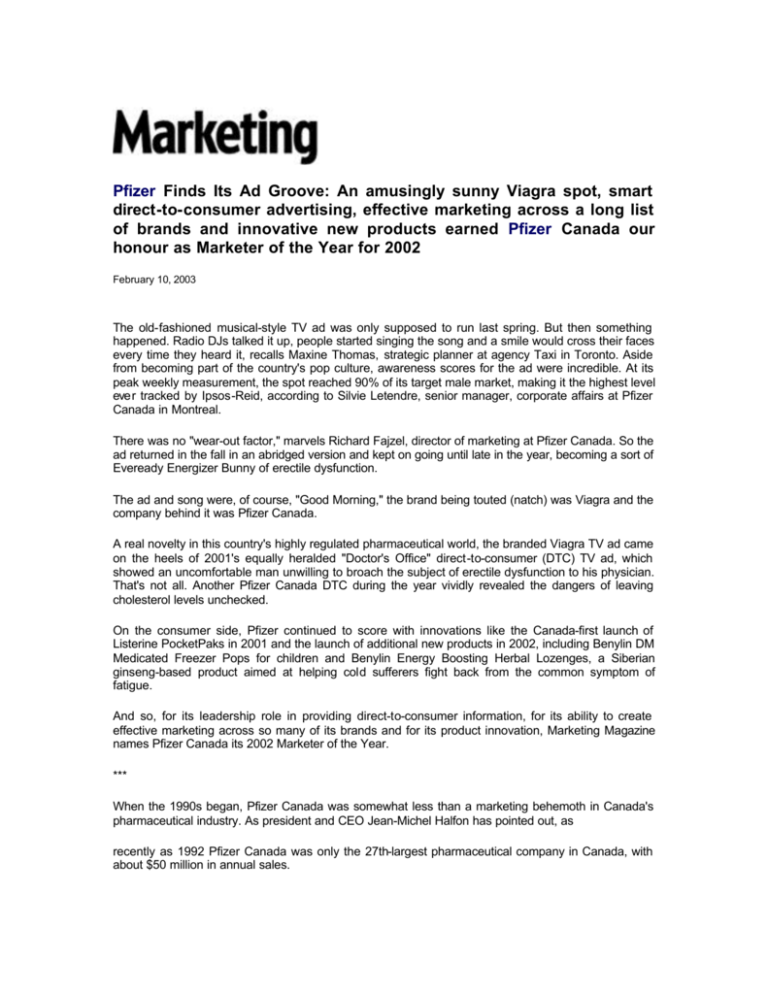
Pfizer Finds Its Ad Groove: An amusingly sunny Viagra spot, smart direct-to-consumer advertising, effective marketing across a long list of brands and innovative new products earned Pfizer Canada our honour as Marketer of the Year for 2002 February 10, 2003 The old-fashioned musical-style TV ad was only supposed to run last spring. But then something happened. Radio DJs talked it up, people started singing the song and a smile would cross their faces every time they heard it, recalls Maxine Thomas, strategic planner at agency Taxi in Toronto. Aside from becoming part of the country's pop culture, awareness scores for the ad were incredible. At its peak weekly measurement, the spot reached 90% of its target male market, making it the highest level ever tracked by Ipsos-Reid, according to Silvie Letendre, senior manager, corporate affairs at Pfizer Canada in Montreal. There was no "wear-out factor," marvels Richard Fajzel, director of marketing at Pfizer Canada. So the ad returned in the fall in an abridged version and kept on going until late in the year, becoming a sort of Eveready Energizer Bunny of erectile dysfunction. The ad and song were, of course, "Good Morning," the brand being touted (natch) was Viagra and the company behind it was Pfizer Canada. A real novelty in this country's highly regulated pharmaceutical world, the branded Viagra TV ad came on the heels of 2001's equally heralded "Doctor's Office" direct-to-consumer (DTC) TV ad, which showed an uncomfortable man unwilling to broach the subject of erectile dysfunction to his physician. That's not all. Another Pfizer Canada DTC during the year vividly revealed the dangers of leaving cholesterol levels unchecked. On the consumer side, Pfizer continued to score with innovations like the Canada-first launch of Listerine PocketPaks in 2001 and the launch of additional new products in 2002, including Benylin DM Medicated Freezer Pops for children and Benylin Energy Boosting Herbal Lozenges, a Siberian ginseng-based product aimed at helping cold sufferers fight back from the common symptom of fatigue. And so, for its leadership role in providing direct-to-consumer information, for its ability to create effective marketing across so many of its brands and for its product innovation, Marketing Magazine names Pfizer Canada its 2002 Marketer of the Year. *** When the 1990s began, Pfizer Canada was somewhat less than a marketing behemoth in Canada's pharmaceutical industry. As president and CEO Jean-Michel Halfon has pointed out, as recently as 1992 Pfizer Canada was only the 27th-largest pharmaceutical company in Canada, with about $50 million in annual sales. But Pfizer is now number one in Canada, number one in market share within the Pfizer global organization, and the first Canadian company with more than $1 billion in pharmaceutical sales. Marketing has played a strong role in that growth. "We are aggressive commercially," says Fajzel, "and if we have a belief that we're going to meet customer needs better than the competition, we're not shy to invest behind our initiatives." Halfon insists, however, that Pfizer Canada is not chockfull of marketing geniuses. Rather, "we do our homework and we measure what we're doing. We're quite analytical in the way we do our marketing. It's the Pfizer approach." At Pfizer, marketing involves preparing the groundwork a full five years before a new product launches-both in identifying opportunities and having an input early in the drug-development process by helping decide what makes it out of the lab. It's something Pfizer calls the BAM (Blockbusters Are Made) process. New products are often launched in environments where awareness levels are not high, patients are undiagnosed and, even among those that are diagnosed, many are left untreated, Halfon says. "The responsibility of marketing is to prepare the market for the product and to prepare the product for the market." Fajzel says Pfizer Canada differentiates itself through its reliance on a therapeutic team-based approach initiated in 1996. For example, Fajzel has three interdisciplinary teams reporting to him, including people in marketing, market research, medical regulation, government affairs, public relations and patient access. The process takes into account multiple stakeholders and ensures the right perspectives help make better decisions for the company's brands. "It's not the traditional brand manager at the centre of a pinwheel running about, using more persuasion to get the buy -in and the commitment from the different units," explains Fajzel. There is also a very strong relationship between sales and marketing, with leadership teams ensuring that critical decisions are vetted by the appropriate interests, he says. Smooth implementation and rollout of strategy is achieved by ensuring all basic marketing and sales fundamentals and clinical regulatory aspects are well covered. Pfizer Canada has been a pioneer in pharmaceutical marketing by taking a look at the total marketing message, says Prem Karunakaran, the founder of Karisma Communications, a Toronto PR firm specializing in pharma that has done work for Pfizer in the past. "They don't skimp," he says. "They leave no stone unturned in product launches." Of course, Pfizer Canada has benefited enormously from the product launches of its New York basedparent, Pfizer Inc., which recently include three of the most successful launches in pharmaceutical history: the statin (cholesterol drug) Lipitor, Viagra and the arthritis treatment Celebrex. As one pharmaceutical analyst noted, it's akin to the New York Yankees fielding Babe Ruth, Joe DiMaggio and Lou Gehrig in one season. Although Viagra is undoubtedly the brand consumers associate most with Pfizer, its flagship product is actually the cholesterol-lowering drug Lipitor, the top-selling drug worldwide. According to IMS Global, worldwide sales of Lipitor reached US$7 billion (C$10.8 billion) in 2001. The drug is on schedule to become the world's first US$10-billion (C$15.5-billion) drug by 2005. The ability to seize on opportunity is one of Pfizer's attributes. For example, Viagra (sildenafil citrate) was originally tested as a treatment for angina. But when it produced an unexpected side effect-better sexual performance-the company shifted gears and began developing the drug for impotence. Another of Pfizer's attributes is the ability to form marketing partnerships. It has co-marketed biggies like Celebrex and Lipitor with competitors. And, in the style of the late Victor Kiam, Pfizer has liked the products it has co-promoted so much it has turned around and bought the companies behind them, including Warner-Lambert. The partnerships only came to pass because of Pfizer's marketing reputation, Halfon says. "These companies had to decide to work with an innovator on these products and they chose Pfizer as the partner of choice." The co-marketing continues this year through the launch with Boehringer Ingelheim of Spiriva, the first once-daily inhaled treatment for chronic obstructive pulmonary dysfunction. *** "Good morning. Good morning! It's so great to be alive..." No discussion of Pfizer Canada's marketing achievements in 2002 would be complete without "Good Morning." To the tune of "Good Morning"-an almost forgotten ditty from the 1952 American movie classic Singin' in the Rain-a middle-aged man (portrayed by actor Andrew Winston) bounds out of his home, merrily makes his way to work and smiles as the elevator door closes-not before jumping newspaper vending machines, breaking up a kids' basketball game to shoot a hoop and gambolling down city streets like a complete nincompoop. The Viagra brand name appears on the screen with the words "Talk to your doctor." (The French version saw Jean-Jacques Streliski, executive vice-president and director, creation and strategy at Taxi Montreal, transform the never-before-translated song to "Quel Beau Matin." The ad was just as successful in French Canada as in English Canada.) Results left Pfizer singin' in all kinds of meteorological conditions. According to Pfizer survey data, 80% of respondents agreed or strongly agreed that Viagra projects a positive image in its advertising, and "significant numbers" of men (more than a quarter of the ED sufferers surveyed) said the ad convinced them to talk to their doctor or partner about ED or Viagra. The "Good Morning" ad "kind of sold itself," says Taxi's Thomas. "I think we knew from the beginning that we had a really strong and powerful idea because we had done so much work leading up to it with the ED sufferer. It was one of the easiest sell-throughs that we've ever had." It did not, however, get the go-ahead until plenty of questions were asked at Pfizer and everybody was comfortable with it, Halfon says. "It was part of a plan. You need that level of analysis in today's environment. If you forget just one stakeholder, you can be sure this stakeholder will not forget you." As soon as it hit TV screens, creatives applauded. "I love everything about this ad," says Michel Ostiguy, president of Bos in Montreal. For a friend's 50th birthday party, Ostiguy went so far as to morph the friend's face into the ad. Every time the commercial aired on TV, the friend's four-year-old daughter said, "Daddy, daddy, it's your ad!" "Good Morning" is an example of great insight, says Philippe Meunier, vice-president, creative director at Diesel Marketing in Montreal, who credits Pfizer with the courage of going beyond the tried and true and leaping into the unknown with the ad. "It struck me and a lot of people in the industry when we saw it on the air," says Daniel Rabinowicz, former president of Cossette Communication-Marketing in Montreal. He recalls former Cossette Montreal VP, creative director Jacques Labelle saying, "Have you seen that 'Good Morning' ad? It's unbelievably brilliant when you cast it in the context of the regulatory environment." The ad was a natural follow-up on the heels of the "Doctor's Office" ED awareness ad, Fajzel says. Aiming to destigmatize what had been a taboo subject, the ad "captured the public's imagination," with results completely exceeding expectations. Eight out of 10 men in the target audience recalled seeing "Doctor's Office," compared to a norm of 4.5 out of 10. "We also had good feedback from physicians calling and saying, 'That's exactly it, that's what we see with this condition.' There's a great wall there and unwillingness to raise the issue." The locker room may be filled with jokes about (ED), "but the reality isn't very funny to the sufferer," Fajzel says. The idea with "Good Morning" was to get people to view Viagra positively, Thomas says, and away from impressions developed by late night talk show hosts. "David Letterman and Jay Leno are the people who kind of positioned Viagra in many people's minds. We wanted to get people to realize that it's not a performance-enhancing drug; it's not something that is meant necessarily to turn you into a love machine, but it actually has an overall benefit in how men feel about themselves." Nobody really knew what to expect because a branded TV ad had not been run before to target potential consumers of Viagra, says Thomas. But in dealing with a delicate subject matter "in a way that was very charming and very responsible, but also very lively and fun," the impact was huge. Not only that, but the joyful gallivanting of the post-Viagra-taking ac tor in "Good Morning"-in clear contrast to the crestfallen patient afraid to talk about his condition in "Doctor's Office"- also served as a cause and effect, Fajzel says. Here's the problem, here's the potential solution. Rabinowicz, who judged the winning "Doctor's Office" for the 2002 CASSIES advertising effectiveness awards, says Pfizer is bound to be back this year for "Good Morning," which was "more brilliant and more breakthrough" than "Doctor's Office." Given the regulatory environment for prescription brands, "Good Morning" "is just a brilliant, brilliant, brilliant solution. Agencies don't get away with that kind of stuff unless you have a really insightful client who gets it and encourages the agency to work that way." Not everybody was in awe of "Good Morning." Said a young female participant in a focus group on advertising held last fall by Leger Marketing in Montreal for Marketing: "It bothers me. I take the remote and zap it. It makes men look like idiots." Appearing in between spring and fall runs of "Good Morning," another ED awareness ad called "Straight Goods" almost got lost in the shuffle. It superimposed black-and-white images -such as a man looking at himself in the mirror, and the man in bed with his spouse, looking discouraged. Facts about ED scroll on the screen, and at the end the ad goes into colour, indicating that there is a solution available. "This one was less flashy," Letendre says. But of all the campaigns, it was rated the most effective at encouraging discussions with doctors and at making sufferers feel more optimistic. There was also less critical acclaim for Pfizer's "Rewind" cholesterol awareness ad, but it too hit home. Going backward in time from a visit to the morgue, to a father's fatal heart attack, to the father playing frisbee in the park with his family, the ad stresses the importance of getting your cholesterol checked. Created by Jeffrey Simbrow Associates in Toronto, the ad started airing last June and ran until November. Results showed that 56% of the target population (men over 40 and women over 50, who are often unaware they have elevated cholesterol) said they intended to speak to a physician. What's more, trends showed a 20% increase in the growth rate of new patients being put on statins. "We attribute this growth to Pfizer's education campaign, since before we started our campaign the market for statins was in decline," Letendre says. *** Although Pfizer got plenty of attention last year from Viagra, erectile dysfunction, cholesterol and the like, its consumer health-care division wasn't exactly forgotten in the back of the medicine cabinet. It was CASSIES-worthy for its still-running Listerine Mouthwash and Listerine PocketPaks campaigns through J. Walter Thompson in Toronto, which show superheros battling the evil monster gingivitis wherever it may strike. New products like Benylin Freezer Pops joined the fray, and old standbys maintained their hold as market leaders. On the consumer side, several competitors' products have similar compounds "and it really becomes a marketing challenge," explains Mark Lemieux, director of marketing and business development at Pfizer's consumer health-care division in Toronto. But "we'd like to grow at above-market rates, and so far we've been quite successful at doing that." One of the keys, he says, lies in product innovation. Rabinowicz cites Michael Unruch, general manager of Pfizer Canada's consumer health-care division, as an unsung hero and the low-key figure behind the division's success. "I would think that probably he's the best marketer in Canada." He credits Unruch with creating a culture that gives permission to people to be gutsy in breaking the patterns of packaged goods marketing and in understanding how original advertising can contribute to the bottom line. The result is a steady stream of innovative work and products. Something like Benylin Freezer Pops "doesn't happen accidentally," says Rabinowicz. "It's gutsy as hell; it's groundbreaking." The frozen concoction has been advertised in a 30-second TV ad created by Bates Canada, in which a girl hides spoons around the house to avoid taking a yucky cough syrup. The tag line goes: "Made for kids. Easy for parents." A New Agey-product like Benylin Energy Plus, Rabinowicz adds, is "not your no-brainer, typical brand extension," and the courage to come out with brands like that will inevitably lead the company to other successes. Lemieux says the recent creation of a customer marketing department-a hybrid of marketing and sales, whose role is to adapt brand strategy and align brand strategies and customer strategies-has been key in assuring that the health-care division has by far the largest portfolio of leading brands in Canada. While new brands like PocketPaks get plenty of ink for rejuvenating Listerine, Lemieux is just as proud of names like Polysporin, which has a 50%-plus share of the country's wound care category. "You don't come across many 50% products in a portfolio," he notes. Others, like Lubriderm, Rolaids and Visine, are leaders or close seconds in their categories. But it's in launching new products like PocketPaks and Freezer Pops in Canada before they make their debut in other countries that Pfizer Canada's consumer health-care division excels. The Canadian operation is setting the kind of path that the U.S. can follow "once they've proven out there in the boondocks of Canada," says Rabinowicz. "I would think there are probably huge lessons learned for the U.S. from the Canadian experience." *** Not everybody is thrilled with the marketing prowess of pharmaceutical firms like Pfizer. Dr. Bob Goodman, a general internist in New York, has established an organization called No Free Lunch that believes pharmaceutical promotion should not guide clinical practice and that overzealous promotional practices can lead to bad patient care. The organization asks physicians four questions, including: "Have you ever prescribed (Pfizer's) Celebrex?" and "Do you drink your morning eye-opener out of a Lipitor (another Pfizer brand) coffee mug?" If yes, "you may be drug company dependent." Goodman says, "It is time to just say no to drug reps and their pens, pads, calendars, coffee mugs and, of course, lunch (not to mention dinners, basketball games and ski vacations)." And he invites practitioners or researchers to take a pledge "to accept no money, gifts or hospitality from the pharmaceutical industry; to seek unbiased sources of information and not rely on information disseminated by drug companies; and to avoid conflicts of interest in my practice, teaching and/or research." Last year, a report by the U.S. consumer health organization Families USA refuted the pharmaceutical industry's claim that high and increasing drug prices are needed to sustain research and development. The 2001 data shows major drug companies spent almost two-and-one-half times as much on marketing, advertising and administration as they did on R&D. "At the same time that drug prices are skyrocketing, pharmaceutical companies are focusing more and more on marketing the most expensive drugs," said Ron Pollack, Families USA's executive director. "The result is a skyrocketing cost spiral." For its part, in 2001 Pfizer Inc. spent 35% of revenues on marketing, advertising and administration, compared to 15% on R&D, the organization reported. Responding to criticism that Pfizer spends too much on marketing, Halfon says a major component of its marketing involves dealing with diseases, not products, in continuing medical education or compliance programs. Although Pfizer is far from unique in this, "what is unique is the level of investment we have in this area," he says. *** While it's already at the top of the pharma world, the future looks even brighter for Pfizer. A US$60billion (C$92.8-billion) merger between Pfizer Inc. and Pharmacia Corp., expected to be completed in the first quarter of this year, will add a host of products to the corporation's consumer and pharma portfolio, including the smoking cessation products Nicorette and Nicoderm. What's also new this year is that Viagra is about to have competition in the erectile dysfunction front. But the company will hardly stand impotently by. How will Pfizer's Viagra marketing change? Not very much, Fajzel says, noting that the newbies will have difficulty competing with Viagra's brand equity. "We're a leader in the area, we built the category and we believe in our product." Bring on the competition, says Taxi's Thomas: "As a market leader, Viagra is in a position to define its own path." (Actually, Pfizer is suing rivals Bayer and GlaxoSmithKline, which are positioning their drug Levitra as being a good choice for diabetics with ED, and Eli Lilly and Icos, whose compound, Cialis, may work longer than Viagra. Pfizer says those rivals would rely on a chemical formula covered by a patent on Viagra.) Lawsuits aside, Fajzel says the upside of greater competition will be increased awareness of ED, which will result in an increased willingness by patients to have their condition treated by physicians and therefore expand the marketplace. "It's very difficult for a single company to move a market from ground zero." Besides, "we always have competitors in any market," Halfon says. What really makes Pfizer different is that it has launched several blockbusters and promises to continue to do so. Says Halfon: "We live on innovation, because 15 years from now all of our products will be genericized. Pfizer will be a company with a set of completely different products." Innovation is at the core of Pfizer's foundation, he says, adding that: "The marketing capabilities of an organization to transform that innovation into success is critical."
